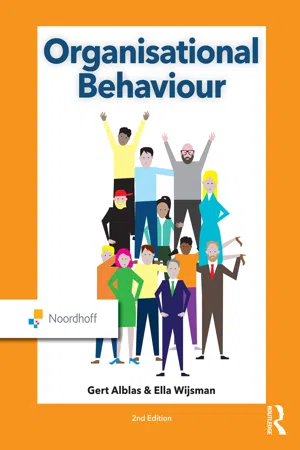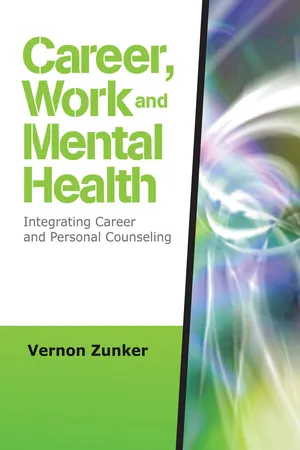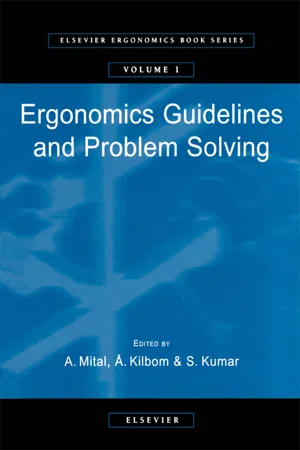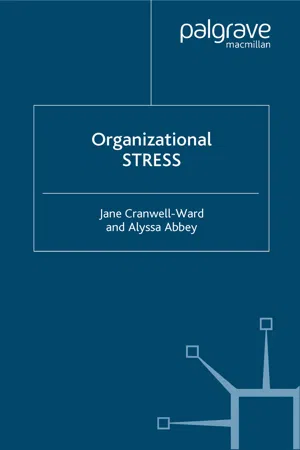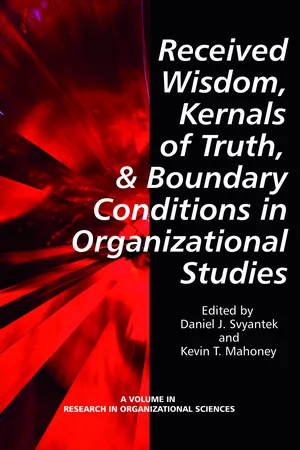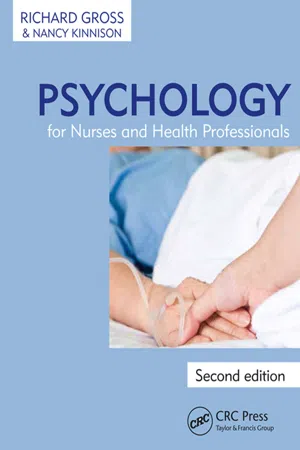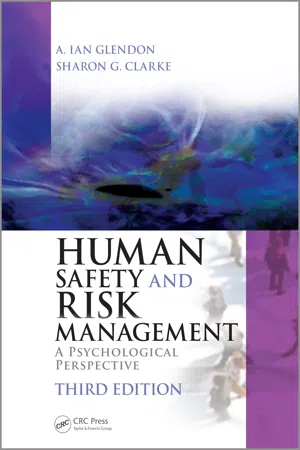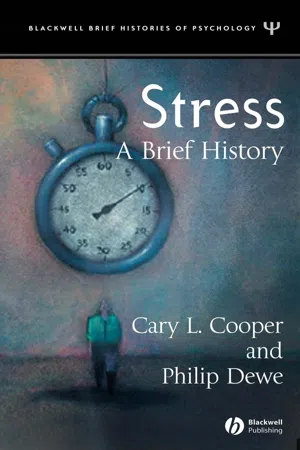Business
Causes of Stress at Work
The causes of stress at work can include heavy workloads, tight deadlines, lack of control, poor management, interpersonal conflicts, and job insecurity. Other factors such as long hours, lack of work-life balance, and organizational changes can also contribute to workplace stress. It is important for businesses to address these factors to create a healthier and more productive work environment.
Written by Perlego with AI-assistance
Related key terms
1 of 5
12 Key excerpts on "Causes of Stress at Work"
- eBook - PDF
- Gert Alblas, Ella Wijsman(Authors)
- 2021(Publication Date)
- Routledge(Publisher)
10.1.1 Stress at work Stress relates to the pressure a person experiences. Perceived pressure Stress causes tension. The body reacts to tension by increasing physiological activity. When this does not result in lowering the tension and the physiological activity persists, exhaustion will result. Resistance to pressure declines and the risk of physical and psychological ill-health increases. Stress at work occurs if a person cannot satisfy the demands of their work. The characteristics of the work or work situation that can cause stress are called stressors.The first example shows how Sandy is continually pressed Stressors for time and never has the feeling that she has her work under control. The stress evoked by this situation causes her headaches, stomach pains and sleeplessness. Not all pressure leads to stress in employees. One person can take more than another and some people thrive under pressure. In a department where everyone has to deliver the same high performance and therefore has the same work load, one employee will experience more stress than another. Work load The effect is related to the extent to which a person can handle the pressure Capacity put upon him. Someone’s capacity or load tolerance is determined by their ability to prevent and cope with stress. A person will experience stress at Recovery time work if there is too little recovery time and if the balance between work load Balance and capacity is seriously or protractedly upset. The perceived pressure will Stress reactions then result in stress reactions (see Figure 10.1). © Noordhoff Uitgevers bv 360 10 FIGURE 10.1 Causes and consequences of tension at work Stressors at work Stress Inadequate recovery time Burden is higher than potential Stress reactions NRC Handelsblad Half of police force under constant stress Half of the 50,000 policemen and women in the Netherlands as suffering from stress- related complaints, says an internal study commissioned by Dutch National Police. - No longer available |Learn more
Career, Work, and Mental Health
Integrating Career and Personal Counseling
- Vernon Zunker(Author)
- 2008(Publication Date)
- SAGE Publications, Inc(Publisher)
Thus, specific job features can pose a threat to the worker. Edwards (1992) suggested that job stress involves inter-actions of work conditions with worker traits that change normal psycho-logical and/or physiological functions. The distinction between work stress and job stress is simply that job stress involves features of a job that exceed the worker’s coping ability, whereas work stress is a broader concept that includes, for instance, the worker’s core beliefs about work per se. In other words, stress related to job conditions can be one factor among others that leads to work stress. Major job stressors are reported by contributing factors and possible consequences in Table 11.1. Helpers are given a substantial overview of potential contributing factors that can affect a worker’s feelings of well-being as well as his or her general health, job satisfaction, and fit. The sources of stress as outlined in Table 11.1 suggest windows of opportu-nity to help clients identify specific areas of concern, such as work over-load, technostress, role ambiguity, under- and overpromotion, spillover, and electronic performance monitoring (EPM; Rice, 1999; Sulsky & Smith, 2005). Work Overload Several types of work overload can be found among professionals or white collar employees as well as assembly plant line workers. Although stress across levels of the workforce may be derived from different sources, the reaction to work overload also has broader consequences. Work over-load is viewed as a compromise between quantity and quality of perfor-mance. Teachers, social workers, and health care workers, for example, typically describe their work demands as excessive. Responses by the indi-vidual worker to the work role, such as reactions to work overload, are key factors in developing interventions. Keep in mind that in all cases there are interacting influences. Role Ambiguity Role ambiguity occurs when workers are not certain as to what manage-ment expects them to accomplish. - eBook - ePub
- A. Mital, Å. Kilbom, S. Kumar(Authors)
- 2000(Publication Date)
- Elsevier Science(Publisher)
Most of these studies demonstrated that workers doing these occupations are likely to experience significant stressors at work, but the studies are difficult to compare since the stressors studied differed greatly and even when the same stressors were studied, measurement methods often differed. Apart from demonstrating that stress should be considered as a factor in all of these jobs, these studies do not contribute a great deal to our knowledge of what the general sources of stress are likely to be.More useful are studies that attempt to look at the effects of specific potential stressors. From these studies it has been established that a range of experiences and factors encountered in the workplace can be stressors. For example, unemployment has been shown to be related to increased psychophysiological symptoms, lower self esteem and increased hostility (Stokes and Cochrane, 1984 ) and job insecurity to decreased personal well-being and deterioration of work performance and attitudes (Roskies and Louis-Guerin, 1990 ). A number of studies have also shown that exposure to a traumatic experience at work can be a potent stressor which has long-lasting effects on individuals who are exposed to it (McGuire, 1990 ).Another factor that has been studied extensively is stress due to the role in the organisation, specifically role conflict (where the demands of the job are not in concert with what the worker believes they should be doing) and role ambiguity (where the worker does not have enough information about his/her work role). Since the original study by Kahn et al. (1964) showing negative effects of role conflict and role ambiguity, there has been a considerable amount of research on the effects of these factors. Jackson and Schuler (1985) performed a meta-analysis on this research and showed significant negative correlations between role conflict and ambiguity and a number of stress-related responses like job satisfaction, participation, commitment and involvement.The role stress plays in the relationship between poor physical aspects of the work environment and work performance is less clear. While there is abundant evidence that work performance is affected by such conditions as poor lighting, noise, heat, cold, glare, etc., stress is not commonly included in the explanation of the mechanism of the effect. Stress can, however, play a secondary role in this relationship (Poulton, 1978 ; Levi, 1987 ). For example, poor lighting is well-recognised to produce poor work performance, because it hampers the worker’s ability to gain enough information from the work environment to complete the task successfully. This then requires the individual to increase the amount of effort required to do the job, thereby increasing their level of stress and affecting work performance (Kahneman, 1973 ; Eysenck, 1983 - eBook - PDF
- J. Cranwell-Ward, A. Abbey(Authors)
- 2005(Publication Date)
- Palgrave Macmillan(Publisher)
prevention and coping with stress identifying and managing stress of others building resilience Job matching Job redesign Counselling Absence management Building a culture and climate for a resilient workforce – see Chapter 13. Dealing with the Root Causes University College London (UCL) has produced a set of guidelines, Manag- ing Stress at Work (www.ucl.ac.uk/hr/docs/stress.php), which suggest that, in managing stress effectively within the workplace, both managers and staff need to be aware of the potential causes of stress as well as the effects. UCL proposes that the causes of stress can broadly be divided into three main categories: 1. Personal Ill health Relationship problems Financial difficulties Family worries 2. Organizational Overwork Feeling of being undervalued Poor communications Job ambiguity Conflict with colleagues 3. Environmental Poor physical working conditions or job design Heat Noise. In addition to these causes, there may be common causes of stress faced by the organization as a whole, such as change imposed following a merger or other external pressures. The model of potential causes presented in Chapter 6 could be helpful to managers particularly when trying to identify problems at the team and individual level. The challenge, therefore, is for managers to identify and respond to poten- tial situations or issues that may come from the employees themselves or the workplace. Managers must work with individuals to encourage them to identify and help them to manage potential stress factors within their own departments or areas of responsibility. In this way, a joint approach to managing stress within the workplace is formed, allowing individuals to understand their own role and accountability relating to workplace stress and, at the same time, enabling them to approach their managers to discuss issues that are causing them stress. 9 MANAGING STRESS WITHIN THE WORKPLACE 83 - Daniel J. Svyantek, Kevin T. Mahoney(Authors)
- 2013(Publication Date)
- Information Age Publishing(Publisher)
Employees experience a range of demands on their jobs. Labeled stressors because they often trigger the stress process, work demands can be categorized as role demands, interpersonal demands, physical demands, workplace policies, and job conditions (Barnett, 1998). Role demands include work responsibilities that interfere with each other such as providing excellent customer service but also keeping up with techni-cal components of the job. Interpersonal demands include stressors that arise out of working with others, like supervision and leadership, team-work, and interpersonal conflicts (i.e., arguments with coworkers or cus-tomer incivility/rudeness). Examples of physical demands include high levels of noise, uncomfortable temperatures, or poor air quality. Work-place policies examples consist of factors such as downsizing, discrimina-tory practices, and staffing/recruitment. Finally, job condition stressors include work overload, time pressure, and low wages. Despite the fact that some of these demands appear to be universally stressful, there are considerable differences in way individuals interpret or appraise those events that may ultimately influence their psychological and physiological impact (Lazarus & Folkman, 1984). The transactional model of stress (Lazarus & Folkman, 1984) proposes that an individual’s experience of stress is a dynamic interaction between the environment and individual perceptions. In order for an event in the environment to become a stressor, it must be perceived as threatening by the individual ( primary appraisal ). Also relevant to this judgment are perceptions of whether one has enough psychological or physical resources to cope with the event ( secondary appraisal ; Lazurus & Folkman, 1984).- eBook - PDF
- Michael A. Hitt, C. Chet Miller, Adrienne Colella, Maria Triana(Authors)
- 2017(Publication Date)
- Wiley(Publisher)
41 Work Overload Another common cause of stress in organizations is work overload. Overload can be quantitative (too much work) or qualitative (work is too complex). Research suggests that qualitative overload creates more stress than quantitative overload. For example, qualitative work overload has been found to create greater depression, less enjoyment of work, and greater hostility. 42 In a study of nurses, those with an overload of complex cases were sick more frequently. 43 Therefore, managers should be very sensitive to overloading associates with work that is too complex for them. Evidence suggests that workload has been increasing over the past few decades. 44 In one study of high earners, 62 percent reported working more than 50 hours per week, 35 percent reported working more than 60 hours per week, and 10 percent reported working more than 80 hours per week. 45 The majority of these respondents also reported qualitative overload such as unpredictability, a fast pace with tight deadlines, and 24/7 client demands. U.S. workers are not the only ones experiencing overload—it appears to be a global phenomenon. The problem of work overload and its ensuing stress-related health conse- quences has become so prevalent in Japan that they have special terms to describe the phenomenon: karoshi, which means “work to death” and karo-jisatsu, which means “suicide by overwork.” 46 Causes for the growth in overload are far ranging, from economic downturns leading to more work for fewer employees, more competitive work environments, and the increasing ease with which employees are available because of technology. “Cell phone thumb” has become an actual medical condition. 47 Another problem associated with work overload is presenteeism, or attending work while sick. When job demands are high, employees may not feel as though they can afford time off when they are sick. - eBook - PDF
- Athel Cornish-Bowden, Cary Cooper(Authors)
- 2004(Publication Date)
- CRC Press(Publisher)
Stress reactions result from the individual’s appraisal of a contextual factor. In addition, employees differ in the way they address stressful work factors (the concepts of active or passive coping). So there is little doubt that stress is indeed an individual phenomenon. To illustrate the role of individual differences, there is the saying that “One man’s meat is another man’s poison.” Indeed, there are large differences between people — differences in personality characteristics, experience, ambitions, and knowledge, skills, and abilities. There are also differences within people: the same “objective” task might be more demanding for someone when he is a freshman than — after a couple of years — when he has become a more experienced employee. Also, when fatigued, the same “objective” task demand is assessed as more demanding than when the employee is not fatigued. Let us consider the examples of mountaineering and lion taming. It is true that some people are fond of climbing mountains or taming wild animals (“One man’s meat is another man’s poison”). We should, however, bear in mind that statistically these are minorities, and that for most persons these activities would be very stressful. The same reasoning applies to the psychosocial work environment. It is true that not all employees prefer skill variety, and it is true that there are people who prefer to work in splendid isolation. But we should not forget that most employees do like to use their skills and to communicate and cooperate with others. In this chapter we have therefore chosen a probabilistic conceptualization of stressors; i.e., certain work characteristics are de fi ned as risk factors when they tend to elicit stress reactions in “most people most of the time, regardless of circumstances” (Sauter et al., 1998, pp. 34.2–34.3). - Richard Gross, Nancy Kinnison(Authors)
- 2017(Publication Date)
- Routledge(Publisher)
75 Stress: Definitions and causes 4 Introduction and overview According to Bartlett (1998), … the notion that stress is bad for you and can make you ill has become a modern cultural truism. However, there is also a significant body of research evidence which lends support to this idea … The study of stress must … be central to … health psychology, which con-cerns, at its most basic level, the role of psychosocial processes in health and disease. Definitions of stress fall into three categories (Bartlett, 1998; Goetsch and Fuller, 1995): 1. Stress as a stimulus 2. Stress as a response 3. Stress as an interaction between an organism and its environment. In turn, this classification corresponds very closely to the three models of stress identified by Cox (1978): 1. The engineering model , which is mainly concerned with the question ‘what causes stress?’ 2. The physiological model , which is concerned with ‘what are the effects of stress?’ 3. The transactional model , which is concerned with both the aforementioned questions plus ‘how do we cope with stress?’ Although stressors are faced by everyone (especially, perhaps, those living in constantly changing Western cultures), some face greater demands than others. As a group, patients (both in and out of hospital) face sources of stress that they did not have to deal with before becoming ill. Similarly, while all 76 Stress: Definitions and causes occupations are stressful, some are more stressful than others. Several studies have suggested that health workers experience more stress than comparable groups of non-health workers (Jones, 1995). In terms of Warr’s (1987) vita-min model, which identifies several environmental factors that affect mental health, nurses and other health professionals are likely to suffer from organ-isational stressors that are common to many other occupations (such as lack of clarity, conflicting roles, work overload and lack of control).- eBook - PDF
- Ana Maria Rossi, James A. Meurs, Pamela L. Perrewé(Authors)
- 2015(Publication Date)
- Information Age Publishing(Publisher)
Both organizations and national economies experience huge costs as a re- sult of stress and mental health disorders. For example, it is estimated that stress costs the U.S. economy $300 billion annually with similarly astronomi- cal estimates derived from the United Kingdom, Canada ($50 billion annu- ally, Mental Health Commission of Canada, 2012) and the European Union (135 million euro annually for depression, McDaid, 2011). Given these figures, it is not surprizing that a great deal of research has accumulated on the causes of stress and numerous taxonomies of stressors exist (for a review see Kelloway & Day, 2005). Although such taxonomies are useful in identifying possible sources of distress in the workplace, the focus on stressors as aversive experiences has created a paradox in the stress literature. The paradox emerges because individuals frequently agree to expose themselves to enhanced levels of workplace stress. For example, although we know that workload is a stressor we also know that many in- dividuals have a seeming inability to say “No,” and as a result take on an enhanced workload. I suggest that any theory of stress must be able to ex- plain this paradox, accounting for both the aversive nature of stress and individual motivation to take on stressful tasks. Contemporary accounts of the stress process resolve this paradox by rec- ognizing that the workplace exposes individuals to both stressors (i.e., de- mands) and resources (e.g.., Bakker & Demerouti, 2007). Demands require physical and/or psychological effort from employees, and are associated with both physical (e.g., fatigue) and psychological (e.g., burnout) con- sequences. Employees also experience resources—aspects of the job that help them deal with demands, and promote personal growth and well-be- ing (Bakker & Dermerouti, 2007). - eBook - PDF
Human Safety and Risk Management
A Psychological Perspective, Third Edition
- A. Ian Glendon, Sharon Clarke(Authors)
- 2018(Publication Date)
- CRC Press(Publisher)
In a maritime environment, Wagenaar and Groeneweg (1987) found that personnel made more frequent errors under high situational stress than would be expected by chance, and that social pressure had a greater influence on job per-formance than did formal rules and procedures. Cooper and Cartwright (1994) identified individual symptoms (e.g., depressed mood and raised blood pressure) as leading to men-tal and physical ill-health, and also organizational symptoms (e.g., high absenteeism, high labor turnover) that led to frequent and severe injuries. This indicated that stress may also have organizational level effects that increase injury likelihood; for example, high absen-teeism may lead to staff shortages, thereby increasing workload on remaining personnel and making errors more likely. The empirical work reviewed suggests that stressors at work contribute significantly to workplace injuries. However, there is also limited evidence to support a relationship between job stress and work-related injuries, such as vehicle crashes. Gulian, Glendon, Davies, Matthews, and Debney (1990) found that driver stress in a sample of United Kingdom drivers was associated with reports of work stressors, such as worries about redundancy and retirement. The authors suggested that work demands could influence some drivers’ general attitude and reactions toward driving. However, these results were not repeated in a sample of Japanese drivers (Matthews, Tsuda, Xin, & Ozeki, 1999), where relatively small associations were found between occupational stressors, such as work demands and driver stress. Trimpop et al. (2000) found that for a sample of veteri-nary surgeons, job stress was significantly correlated with work injuries but not with car crashes. - eBook - PDF
Stress
A Brief History
- Cary Cooper, Philip J. Dewe(Authors)
- 2008(Publication Date)
- Wiley-Blackwell(Publisher)
In their 1979 art-icle, Beehr and Newman identified under their heading of Human Consequences Facet – psychological health consequences, phys-ical health consequences, and behavioral consequences (1979, pp.672–3). Since that time most major reviews have classified job related strains under those three headings – psychological, physiological, and behavioral. Just as earlier researchers may have searched for general or more specific responses to stress, the search for the effects of work stress has been influenced, not so much by an indiscipline on the part of researchers to measure whatever pleases them, but by the fact that being under stress meant that virtually any strain or response could be described as a stress response. This has led to considerable ambiguity as to what we mean when we talk about ‘‘being under stress,’’ and a division, among researchers, as to how worthwhile the term ‘‘stress’’ really is. While we will return to the question of ‘‘what do we mean by stress,’’ it is clear that researchers have, over the years, ‘‘only paid moderate attention to delineating the strain side of the stress transaction’’ (Cooper et al., 2001, p.72). The cost of regarding any response as a stress response, means that our understanding of whether some work stressor produces specific effects has not advanced. Some stressors may be de-scribed as having little or no effect, when it may be more likely that the ‘‘wrong’’ effects have been measured. In addition, few attempts have been made to consider what type of response might be anticipated in different contexts. It is also necessary to move, as Kahn and Byosiere (1992) suggest, from the more gen-eric categories of strains to a more detailed understanding of the nature of strains, in terms of whether they are acute or chronic, reflect over or under stimulation, and reflect more general or STRESS: A BRIEF HISTORY 93 - eBook - PDF
- Julian Barling, E. Kevin Kelloway, Michael R. Frone, Julian Barling, E . Kevin Kelloway, Michael R. Frone(Authors)
- 2004(Publication Date)
- SAGE Publications, Inc(Publisher)
Specifically, highly involved employees reported more negative job attitudes, more health problems, and a higher level of psychological distress than their less-involved counterparts when they perceived their jobs to be threatened. These results and those of other similar research (e.g., Wiesenfeld, Brockner, Petzall, Wolf, & Bailey, 2001) imply that individuals who consider their jobs to be quite important, and whose jobs may be sig-nificant to their self-identity or financial security, are more at risk for nega-tive outcomes as a result of job insecurity than individuals who are relatively indifferent to their jobs. Again, by extension, one would expect that similar findings would be found in the contexts of underemployment and unemploy-ment as well. Although there are organizational implications to the individual differ-ences research discussed above, there are limitations to modifying individual differences variables. For example, organizations cannot change employee cultural values or levels of job involvement in an effort to ward off the neg-ative effects of economic stress. However, research has shown that there are a number of organizational interventions that can be utilized to moderate the effects of economic stress, and these will be discussed below. Organizational level moderators. One of the major sources of stress during times of organizational change is the uncertainty associated with such change. Whether an organization is restructuring, merging with another organiza-tion, or downsizing, research has shown that employees face great job inse-curity during those periods. Recently, there have been a series of studies (Appelbaum & Donia, 2001; Probst, 2003c; Schweiger & DeNisi, 1991) conducted to assess the effectiveness of one organizational intervention— increased organizational communication—designed to reduce the conse-quences of such uncertainty.
Index pages curate the most relevant extracts from our library of academic textbooks. They’ve been created using an in-house natural language model (NLM), each adding context and meaning to key research topics.
